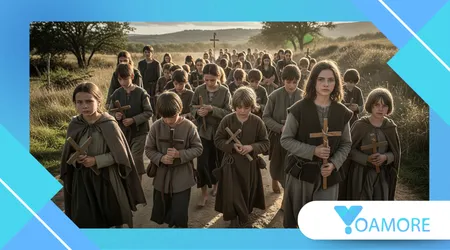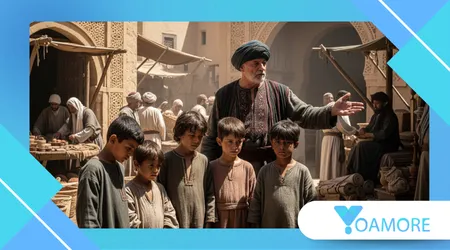Der mittelalterliche Kinderkreuzzug, der in einer Tragödie endete

Die Geschichte des mittelalterlicher Kinderkreuzzug ist ein ergreifendes und oft übersehenes Kapitel der Geschichte.
Anzeigen
Diese faszinierende Erzählung regt die Fantasie an und bietet einen komplexen Blick auf Glauben, Unschuld und die oft düsteren Realitäten der mittelalterlichen Welt.
Die Ereignisse des Jahres 1212 sind zwar mythenumwoben, offenbaren aber eine tragische und fesselnde Geschichte. In diesem Artikel untersuchen wir den historischen Kontext, die herausragenden Anführer und die verheerenden Folgen dieser einzigartigen Bewegung.
Wir werden uns mit den sozialen und religiösen Kräften befassen, die dabei eine Rolle spielen, und untersuchen, warum sich Tausende junger Menschen auf eine Reise begaben, die letztlich zu Herzschmerz und Verlust führte.
Ein Funke des Glaubens in einer unruhigen Welt
Das frühe 13. Jahrhundert war eine Zeit enormer religiöser Inbrunst und sozialer Unruhen.
Anzeigen
Gescheiterte Militärkampagnen im Heiligen Land haben viele Erwachsene desillusioniert, doch der Wunsch, Jerusalem zurückzuerobern, blieb stark.
In diesem Umfeld wurden die Samen der mittelalterlicher Kinderkreuzzug wurden gepflanzt.
Diese Bewegung entstand aus dem starken Glauben, dass die Unschuldigen und Reinen dort Erfolg haben könnten, wo korrupte Ritter versagt hatten.
Es herrschte die tiefe Überzeugung, dass Gott denen mit reinem Herzen den Sieg schenken würde.
Die Vorstellung, dass Kinder, frei von Sünden, auf wundersame Weise einen Weg ins Heilige Land ebnen könnten, faszinierte viele Menschen. Die Botschaft verbreitete sich rasch und fand sowohl bei den Verzweifelten als auch bei den Gläubigen fruchtbaren Boden.
Der Aufstieg zweier junger Führungskräfte
Zwei zentrale Figuren traten hervor, die jeweils eine eigene, aber gleichermaßen tragische Bewegung anführten. Der erste war Stephan von Cloyes, ein junger französischer Hirtenjunge. Er behauptete, eine göttliche Botschaft von Jesus Christus erhalten zu haben.
Er sagte, Jesus habe ihm einen Brief für den König von Frankreich anvertraut, in dem er ihn drängte, einen neuen Kreuzzug anzuführen.
Stephan sammelte schnell eine große Anhängerschaft junger Menschen um sich, vor allem aus der Bauernschaft, die von seiner charismatischen und leidenschaftlichen Botschaft angezogen wurden.
In Deutschland führte derweil ein Junge namens Nikolaus von Köln eine ähnliche Bewegung an. Auch er berief sich auf göttliche Inspiration und behauptete, Gott werde das Mittelmeer teilen, damit sie zu Fuß ins Heilige Land gelangen könnten.
Beide Politiker mobilisierten Tausende von Kindern, Jugendlichen und auch einige Erwachsene und versprachen ihnen eine wundersame und triumphale Reise zur Rückeroberung Jerusalems. Ihr jugendlicher Optimismus war ansteckend.
Der Marsch zur Tragödie
Im Sommer 1212 begannen Tausende dieser jungen Kreuzfahrer ihren Marsch. Die französische Gruppe, angeführt von Stephan, zog in Richtung Paris und dann weiter nach Marseille, einer wichtigen Hafenstadt am Mittelmeer.
Ihre Reise war lang und brutal. Viele starben an Hunger, Krankheiten und Erschöpfung, bevor sie die Küste erreichten.
Statt einer wundersamen Teilung der Gewässer waren sie skrupellosen Kaufleuten ausgeliefert.
Auch das deutsche Kontingent unter Nikolaus musste enorme Strapazen ertragen. Sie überquerten die Alpen zu Fuß, eine gefährliche Reise, die unzählige Menschenleben forderte. Schließlich erreichten sie den italienischen Hafen Genua.
Das versprochene Wunder blieb aus. Das Meer teilte sich nicht. Viele der jungen Kreuzfahrer, müde und desillusioniert, kehrten entweder um oder wurden von einheimischen Familien aufgenommen.
Das düsterste Ergebnis: Verrat und Versklavung

Das tragischste Ergebnis der mittelalterlicher Kinderkreuzzug In Marseille fand ein Krieg statt. Zwei Kaufleute, Hugo der Eiserne und Wilhelm das Schwein, boten freie Überfahrt ins Heilige Land an. Sie versprachen, die restlichen Kreuzfahrer zu transportieren.
Stattdessen segelten sie nach Algerien und Ägypten, wo sie die Kinder in die Sklaverei verkauften. Dieser herzzerreißende Verrat ist eines der ernüchterndsten Details dieses historischen Ereignisses.
Das Schicksal dieser Kinder diente jahrhundertelang als warnendes Beispiel. Es unterstrich die extreme Verletzlichkeit der jungen Menschen und die rücksichtslose Ausbeutung, der sie in einer von Gier getriebenen Welt ausgesetzt sein könnten.
Die Folgen hinterließen tiefe Spuren in der europäischen Gesellschaft. Die Erinnerung an das Opfer der Kinder blieb bestehen, doch das endgültige Scheitern ihres Kreuzzugs zementierte eine düstere Realität.
+ Die vergessenen Codeknackerinnen des Zweiten Weltkriegs.
Den historischen Kontext und die Motivationen verstehen
Historiker haben lange über die wahre Natur der mittelalterlicher Kinderkreuzzug. Handelte es sich um eine echte religiöse Bewegung oder um etwas anderes? Ein wichtiger Aspekt, den es zu berücksichtigen gilt, ist die soziale Zusammensetzung der damaligen Zeit.
Viele dieser Kinder kamen aus verarmten ländlichen Gebieten, wo das Leben hart war und es kaum Aussichten gab.
Der Kreuzzug versprach ihnen Sinn, Abenteuer und göttliche Erlösung – eine überzeugende Alternative zu ihrem schwierigen Leben.
Der mächtige Einfluss religiöser Rhetorik kann nicht genug betont werden. Predigten und volkstümliche Geschichten über Heilige und Wunder schürten den Glauben, dass Gott auf ihrer Seite sei.
Ein weiterer Faktor war das Konzept der Pilgerfahrt, eine im Mittelalter weit verbreitete Praxis. Für diese Kinder war der Kreuzzug eine Pilgerfahrt im großen Stil, deren endgültiges Ziel die heiligsten Orte waren.
+ Die Bostoner Melasseflut: Eine klebrige Katastrophe, von der Sie noch nie gehört haben
Fakten von Fiktion trennen: Eine historische Perspektive
Die Ereignisse des Jahres 1212 wurden im Laufe der Jahrhunderte stark mythisiert. Viele frühe Berichte sind unvollständig oder wurden ausgeschmückt. Die moderne Geschichtsforschung bietet jedoch ein klareres Bild.
Zum Beispiel Historiker Peter Raedtsargumentiert in seinem Werk „Der Kinderkreuzzug von 1212: Eine Neuinterpretation“, dass es sich bei den Teilnehmern nicht nur um kleine Kinder gehandelt habe, sondern dass sich unter ihnen auch viele Teenager und junge Erwachsene befunden hätten.
Er weist darauf hin, dass das lateinische Wort „pueri“ „Kinder“, aber auch „Jungen“ oder „arme Leute“ bedeuten könnte, was auf eine komplexere Bevölkerungsstruktur schließen lässt als bisher angenommen.
| Demografische Analyse der Teilnehmer | Geschätzter Prozentsatz |
| Kinder (unter 12 Jahren) | 20% |
| Jugendliche (13-18) | 50% |
| Junge Erwachsene (19+) | 20% |
| Erwachsene (Begleitpersonen) | 10% |
Diese Neuinterpretation stellt das gängige Bild einer Bewegung in Frage, die ausschließlich aus kleinen Kindern besteht, und hebt die Anwesenheit älterer Jugendlicher und sogar einiger Erwachsener hervor.
Ausführlichere Informationen zu diesem Thema finden Sie in dieser umfassenden Ressource zur mittelalterlichen Geschichte.
Die tragischen Parallelen zu modernen Ereignissen
Die Geschichte des mittelalterlicher Kinderkreuzzug wirkt überraschend zeitgemäß. Es ist eine eindringliche Erinnerung daran, was passieren kann, wenn Unschuld auf Ausbeutung trifft und Idealismus auf Realität prallt.
Stellen Sie es sich wie eine virale Social-Media-Bewegung von heute vor, bei der sich eine leidenschaftliche, aber naive Gruppe für eine Sache einsetzt.
Sie glauben an die Macht ihrer Überzeugungen, doch ohne die richtige Anleitung oder einen realistischen Plan können sie anfällig für Manipulation und Schaden werden. Dabei spielen dieselben menschlichen Schwächen eine Rolle.
Die Geschichte beleuchtet die universellen Themen Hoffnung, Glaube und die Zerbrechlichkeit jugendlicher Träume.
Es ist ein eindrucksvolles Zeugnis für den anhaltenden menschlichen Wunsch nach einem besseren, sinnvolleren Leben, selbst angesichts unüberwindlicher Hindernisse.
Welche Lehre können wir aus einer solchen Tragödie ziehen? Sie erinnert uns daran, dass Glaube und Hoffnung zwar mächtige Kräfte sind, aber mit Weisheit und einem sorgfältigen Verständnis der Welt gemildert werden müssen.
+ Code-Switching in sozialen Medien: Ein modernes Identitätsmerkmal
Vermächtnis und nachhaltige Wirkung
Das Erbe der mittelalterlicher Kinderkreuzzug ist komplex und nachhaltig. Es ist keine Geschichte eines militärischen Sieges, sondern eine eindringliche Erzählung über menschlichen Geist, Glauben und die dunklen Folgen der Naivität.
Es dient als warnendes Beispiel vor der Ausbeutung junger und verletzlicher Menschen. Das tragische Ende des Kreuzzugs warf einen langen Schatten und beeinflusste über Generationen hinweg die Sicht der Gesellschaft auf Kinder und religiösen Eifer.
Dieses historische Ereignis hat unzählige literarische, künstlerische und musikalische Werke inspiriert und seinen Platz in der Vorstellungswelt der Menschen gefestigt. Es erinnert uns daran, dass selbst die wohlmeinendsten Bewegungen ein tragisches Ende nehmen können.
Letztendlich ist dieses historische Ereignis ein Beweis für die Macht des Glaubens, sowohl im Guten als auch im Schlechten.
Die Erinnerung an diese Kinder hallt durch die Jahrhunderte hindurch nach, ein düsteres Echo einer Zeit großen Glaubens und großer Verluste.
Eine ausführliche Analyse der kulturellen Auswirkungen dieses Kreuzzugs finden Sie hier.
